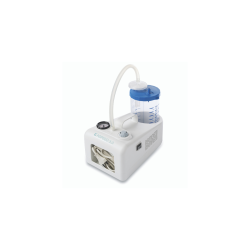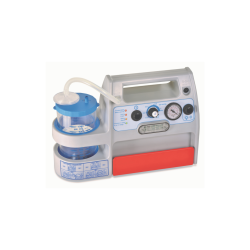Medical Aspirators
There are 3 products.
Active filters
About Medical Aspirators
Essential Suction Equipment for Airway Management
Medical aspirators provide critical suction equipment enabling airway clearance and secretion management across hospitals, care homes, clinics, and home care settings throughout England, Scotland, Wales, and Northern Ireland. These vital devices generate negative pressure removing fluids, secretions, and obstructions from airways and surgical sites, supporting respiratory function, preventing aspiration, and facilitating various clinical procedures. Healthcare environments rely on medical aspirators for airway clearance in patients unable to clear secretions independently, emergency airway management removing obstructions, surgical procedures requiring operative site suction, oral care preventing aspiration, and managing excessive secretions in palliative care. Modern medical aspirators incorporate features including portable battery-powered operation enabling use anywhere, adjustable suction pressure accommodating varied applications, collection bottles capturing aspirated material, bacterial filters preventing cross-contamination, and quiet operation minimising disturbance. The provision of reliable medical aspirators ensures rapid response to airway emergencies, supports respiratory care for vulnerable patients, enables safe surgical practice, and demonstrates appropriate clinical equipment provision across professional healthcare environments.
The implementation of medical aspirators directly supports CQC compliance through enhanced patient safety during airway management, respiratory support for vulnerable patients, and demonstration of appropriate emergency equipment provision. Patients unable to clear secretions face serious risks including airway obstruction potentially causing respiratory arrest, aspiration pneumonia from secretions entering lungs, respiratory distress from secretion accumulation, and choking from oral secretions. Medical aspirators address these challenges by enabling rapid secretion removal preventing obstruction, supporting patients with impaired cough or swallow, facilitating safe oral care in vulnerable patients, and providing emergency intervention capability for airway emergencies. Clinical applications include tracheostomy care removing secretions from artificial airways, neurological conditions when patients cannot clear secretions, palliative care managing terminal secretions compassionately, post-operative care clearing surgical site fluids, and emergency response to choking or airway obstruction. Healthcare organisations benefit from reduced respiratory complications through effective secretion management, prevented aspiration events avoiding serious infections, enhanced safety through emergency airway equipment availability, and improved quality of life for patients requiring regular suction. Modern aspirators incorporate safety features such as overflow protection, pressure regulation, and alarm systems throughout England, Scotland, Wales, and Northern Ireland.
Selecting and implementing medical aspirators requires assessment of clinical requirements, appropriate equipment specification, and comprehensive training across healthcare facilities throughout the UK. Organisations should evaluate patient populations determining suction requirements, assess usage scenarios identifying needs for portable versus fixed systems, and consider clinical applications requiring specialist features. Equipment selection should prioritise appropriate suction strength for intended applications, battery operation for portability and emergency use, adequate collection capacity, bacterial filtration preventing cross-contamination, and quiet operation particularly for palliative care. Implementation protocols must encompass comprehensive staff training on safe suction technique including catheter selection and insertion, appropriate suction pressure and duration, emergency airway suction procedures, and equipment maintenance. Quality assurance measures should include regular equipment testing ensuring functionality, documented maintenance schedules, cleaning and disinfection protocols, and monitoring of suction-related incidents. Modern aspirators incorporate features such as rechargeable batteries, LED indicators, and ergonomic designs. Organisations should establish protocols for aspirator availability including emergency access, integrate with clinical policies for airway management and infection control, and maintain equipment inventories. Clinical teams should understand appropriate suction indications, correct technique preventing airway trauma, catheter selection for different applications, and recognition of complications. Staff education should address suction risks including hypoxia, trauma, and infection, emphasising appropriate technique and monitoring. Equipment management should ensure regular servicing, availability of consumables including catheters and collection bottles, and backup equipment for critical areas. By maintaining medical aspirators and implementing professional suction protocols, healthcare organisations throughout England, Scotland, Wales, and Northern Ireland demonstrate their commitment to CQC standards, patient safety through effective airway management, respiratory support for vulnerable patients, emergency preparedness, and provision of essential equipment enabling life-saving interventions and supporting quality of life for patients requiring secretion management across all care settings.



